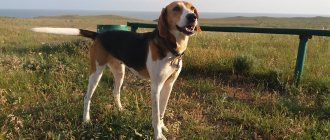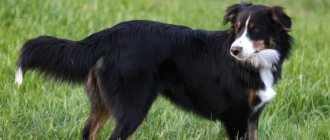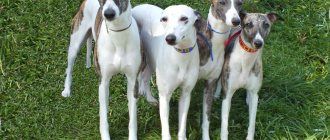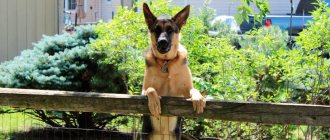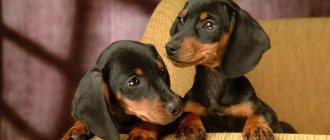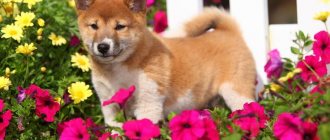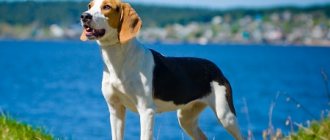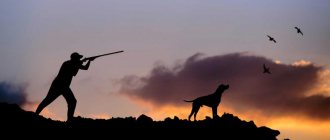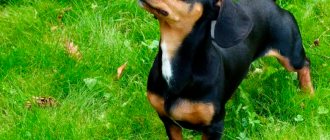Hound dogs are beautiful, active and agile animals. There are 2 popular breeds: English and Russian piebald hound. The name “hounds” comes from the word “drive”; it speaks for itself: initially people got dogs for the purpose of hunting hare, wild boar, and fox. Hound dogs were in demand among noble nobles: they once again confirmed the high status of the owner.
Hound dogs are beautiful, active and agile animals.
Hound dogs in history
The breed became widespread during the Middle Ages. The hound dog is very dexterous and will happily help its owner find prey. When the prey is about to leave, the dog quickly corners it. The speed of reaction made hounds so popular. In Rus', these dogs were called vyzhlovki and vyzhlovki. They followed the trail without hindrance and led the owner. The dogs were also called yappers: when they followed the trail, you could hear a loud bark, and when they lost the trail, they fell silent. Hounds help with hunting. They literally lead the owner to the game.
Classification of hounds
The Fédération Cynologique Internationale divides hounds into three main groups: hounds, pack dogs (who chase prey by following the blood trail), and related dogs.
Hounds, in turn, are divided into large, medium and small. Popular large breeds include Foxhound, Bloodhound, Russian Hound, Biyi, and Poitevin. The middle ones include Harrier, Estonian, Finnish, Swiss, and Polish hound breeds. Among small animals, beagles and basset hounds are loved by dog breeders. Typically, hunters prefer large and medium-sized dogs, and small hounds often become pets.
Related breeds of hounds can be counted on the fingers of one hand. However, they include not only the rare Rhodesian Ridgebacks, but also the very common Dalmatians.
Features of behavior and education of hounds
Today people also breed hounds, they are needed for various purposes, not necessarily for hunting. The breed has many characteristic features, and the owner must clearly know why he is breeding such dogs. You should pay attention to your pet. He needs long walks, but it is better not to walk him near the road.
The dog must always be on a leash, otherwise it may simply run away.
The name “hounds” comes from the word “drive”, it speaks for itself: initially people got dogs for the purpose of hunting hare, wild boar, fox
The pet needs to be controlled and raised very well. He can be trained to different commands. You need to show persistence, courage and rigor in raising these animals. They have an innate instinct to intimidate and corner their prey. Puppies and adult males run fast - this is another distinctive feature. If necessary, an adult dog can run 7 km unhindered, while maintaining the pace. The hound has developed limbs - this allows it to run for a long time and not stop.
If you are a hunter, a hound will help you in a difficult task. But to hunt on Russian territory, you need to go to a special reserve. Dogs help in hunting hare, wild boar, fox, even bear. For hunting, you can use not one dog (bitch), but two.
It is important to know: the hound loves a pack lifestyle, but you can get one individual by teaching it all the necessary commands. Experts recommend taking kids, and they should learn from adults. If you want to take not one, but 2 dogs, you need to make sure that one is the leader and the other is the follower.
Hunting breeds
Next, we present a list of the dogs most in demand by hunters, the top 12 purebred helpers.
1. Dratahaar is a universal breed, suitable for hunting meadow, field, swamp, waterfowl and upland game.
Strengths: endurance, high intelligence, perseverance, innate ability to fetch, hard coat that protects from cutting grasses, thorns and cold - the dog will not freeze even in winter in icy water.
2. Kurzhaar. It is also considered a versatile hunting breed. Among her strengths are noted: high mobility, developed thanks to strong muscles, love of water and the ability to swim well, as well as considerable endurance.
It is not recommended for people who are not involved in hunting to own a drathaar and shorthaired pointer.
These breeds have a specific, irrepressible temperament, so a quiet life without adventure and prey is not for them.
3. The English Cocker Spaniel, despite its cute appearance, deservedly belongs to the category of hunting dog breed: the photo and name of this hunter terrifies birds.
Advantages of the breed: excellent sense of smell, speed and style of movement specifically for catching birds, perseverance, ability to fetch and obedience.
4. The Jagdterrier is a universal hunting breed, originally bred as a burrowing dog.
Strengths: fearlessness, perseverance, endurance, anger towards predators.
5. Fox Terrier. It is impossible to imagine hunting dog breeds with photographs and names without this beautiful burrowing bloodhound, designed to find and pursue foxes, badgers and other small game.
Advantages of a fox terrier: courage, anger towards predators, mobility, ability to navigate in a dark hole, good instinct.
6. The West Highland White Terrier is also a burrowing hunter, used to chase foxes, badgers, and moles.
The advantages of this breed of small hunting dogs: excitement, the ability to predict the behavior of an animal in a hole, courage.
7. The Rhodesian Ridgeback is a hound dog and is used for hunting wild boars, foxes and hares.
Strengths: endurance, agility, mobility.
8. The dachshund belongs to the burrowing bloodhounds.
Dachshund
The choice of dogs for hunting badgers and foxes is often made in favor of the dachshund, because its main advantages include: high intelligence, courage, instinct to pull game out of holes, and excellent instincts.
9. The Miniature Schnauzer is used for hunting foxes, hares, rodents and other small game.
Miniature Schnauzer
Innate qualities: courage, endurance, mobility, energy.
10. The Jack Russell Terrier is a burrowing dog, and is used for hunting badgers, foxes, and is also good at baiting roe deer and wild boars.
Jack Russell Terrier
Strengths: endurance, anger towards the predator, courage, mobility and strength.
11. The beagle belongs to the group of hound dogs; they go with him to hunt a hare, a fox and even a wild boar.
The advantages include: activity, courage, mobility, perseverance.
12. Basenji is used for hunting small game.
Advantages: speed, maneuverability, good instincts, high intelligence.
Which dog should you choose for hunting? The main thing is to clearly understand in advance what type of fishing you need a puppy for. And then everything will depend on proper upbringing, because the innate instincts of such breeds are very strong.
Additionally, check out the video about hunting dog breeds:
Appearance of the hounds
The dogs are not too tall, their height is slightly above average. Adults reach 65 cm in length. The body has a clear outline. Some dogs have slightly protruding ribs. Males and females have long powerful legs and a short tail. The hounds' muzzle is elongated and their ears droop. They have a beautiful neck and straight-set eyes. The look is clear and lively.
The pet needs to be controlled and raised very well
Hounds are quite active. Their fur is not very long. The Hanoverian breed has a long-haired coat. There are several regions in Russia where dogs of this breed are bred. As for the coloration, hounds have a variety of colors: there are tricolor speckled and crimson. The paws are powerful, the muscles are strong. The dog has large paw pads, a straight tail raised up. This breed has its own unique characteristics. Puppies are not cheap. Before adopting a baby, it is recommended to look at the pedigree and verify the authenticity of the documents.
Large dogs
American Foxhound
The dogs, descended from crossing French and English hounds, are distinguished by their elegance, amazing sense of smell, energy and great speed. They are affectionate at home and warlike in hunting conditions. They are considered the luckiest dogs in hunting wild animals.
English Setter
The dog has a lively temperament, cheerful disposition and intelligence. Suitable for keeping in an apartment. The coat is long and gets tangled after running. Brushing is required. Also required: regular exercise, proper education, eye washing.
Biyi
Crossed from forgotten breeds: Montenebeuf, Seri and Larry. Biyi are strong, graceful and tall (height 62-67 cm, weight up to 30 kg). They have: a square muzzle, flat ears, mobile eyes, short hard hair and mobile eyes, white color with a yellowish or grayish tint. Dogs do not know fatigue, are proud and brave. The best deer and roe deer hunters. The voice has different timbres!
Large breeds of hound dogs not recognized by the FCI:
- Russian hound.
- Russian piebald hound.
Video
Gallery: hound dogs (25 photos)
Character and characteristics of the breed
The main character traits of the Coonhound are flexibility and amazing hard work.
Representatives of the breed are considered real masters in hot pursuit. Thanks to its excellent sense of smell, agility, tenacity and endurance, not a single predator can escape the raccoon hound. Also, the red-speckled coonhound will become a real favorite for the whole family. He is endlessly devoted to his owner and his family. In addition, thanks to his activity and curiosity, he simply loves games and walks with children. But it is advisable to ensure that small children do not bother the dog too much, because no one will like it if he is constantly pulled by the ears or pulled by the tail.
English Foxhound breed
Foxhound is an English hound. This is one of the most popular breeds. This dog has the blood of ancient hounds, terriers and greyhounds. Males have a strong build and thick, high paws. They began to be bred in England more than 200 years ago. The Foxhound is considered a national breed and is suitable for bird hunting.
The British bred not only foxhounds, but also larger types of dogs, their breed was called deer hounds. Today this breed has not survived. The Foxhound helped to hunt not only birds, but also foxes: the name of the breed literally translates as “Fox Race”. Males and females can easily withstand racing; they are hardy, agile and very fast. A dog can run 20 km without stopping.
Unlike other hounds, her senses are slightly weakened. Today, hunting with foxhounds is of sporting interest. X owners love to set their pets off on the wrong trail, but the agile foxhounds still run forward. This breed was often exported to America and European countries. In Russia, on their basis, the Russian piebald hound was created. The Americans created their own hound for hunting raccoons.
History of the group of hound breeds
Hounds are the oldest group of breeds, the first information about which appears in Ancient Egypt. Images of dogs similar in appearance to hounds are preserved on frescoes and papyri. From these dogs came the primitive African and Oriental hounds.
In his writings on hunting, Xenophon (c. 430–354 BC) mentions dogs hunting wild boar, deer, and hares with men. The general characteristics sounded like this:
- big size;
- light, sinewy head with a blunt nose;
- black and shiny bulging eyes;
- wide, large forehead with a deep groove;
- mobile, long, flexible neck;
- wide, well-muscled chest;
- straight, strong, lean paws;
- thin sides not too sunken and not too protruding;
- steep, muscular thighs;
- thin, straight tail, at least to the hock;
- vigilance and good teeth are required;
- colors: crimson, black, crimson-piebald;
- general appearance: strong, proportional dog;
- manner of work: non-stop chasing, strong, with squealing and barking. When chasing, the dog runs in frequent leaps, does not leave the trail and does not return to the owner.
Hounds have been known since ancient times
Another ancient Greek writer, Cimon of Athens, writes about several types of hounds: Cretan, Indian, Laconian and Locridian. They were used for bullying. The dog, following the trail, had to remain silent and only raise its voice when it saw the animal.
The heyday of hound dogs occurred in the Middle Ages. England and France made a particularly large contribution. In England, hounds were bred to hunt certain game (for example, beagles and harriers for hare hunting, otterhounds for catching otters, deerhounds for hunting deer, etc.). In France, the birthplace of parforce hunting, the variety of hounds was even greater, but most of them have been lost in our time.
Such diversity appeared due to its arrival in Europe in the 7th-5th centuries BC. Celtic hound dogs. These were solid-colored (sand or brown) dogs with a strong hunting instinct. Their main “talents” were pursuit of the beast and an excellent ability to navigate on any terrain. These were universal dogs, which served as the main material for the Anglo-French hound breeds.
Hounds developed in European conditions
In the Middle Ages, small hunting dogs were bred in Switzerland, which became the ancestors of the Estonian and Swedish hounds. There were also mountain hounds that hunted mountain animals (chamois, goats). In the 18th century, blood trail hounds developed, which were trained to silently pursue a wounded animal.
Hounds in Russia have a special history. Dogs for driven hunting are first found on the frescoes of the Kyiv St. Sophia Cathedral (11th century). The first official publication about hounds was made in 1815 by V.A. Levshin in the “Book for Hunters”.
In Russia, hunting with hounds was carried out in packs. So-called hunts were formed, in which the strongest dogs were selected. Each hunt had a name - for example, Pershinskaya, Glebovskaya, Meshcherskaya (usually after the name of the area or the surname of the owner).
Hounds are designed to herd animals
Selection as such for Russian hounds did not exist until 1874 (the date of the first dog show in the Russian Empire). Before that, many types of hounds were described: harlequins, broad-chested, Courland, Kostroma, Polish paraty, Polish heavy and hare, Anglo-Russian and English small-footed, Russian straight-legged and steep-legged.
These dogs had in their ancestors shepherd dogs (brown-chested), mastiffs and artois (harlequins), foxhounds and French hounds (Anglo-Russian), early Latvian hounds (Courland) and other breeds. This lack of selection affected the type: by the second half of the 19th century, Russian hounds did not yet have an established type. But after 1874, it was decided to start breeding a breed of the same type.
From the total mass, the Anglo-Russian (Russian pinto) and the Russian hound were distinguished, which still exist.
Hounds are excellent hunters
Beagle is another breed of hound
The Beagle is another breed that originated in England. In the old days, beagles hunted hares. They often interacted with foxhounds. These dogs have a well-developed sense of smell, they are fast and strong. Among the external features, it is worth noting the beautiful color. Individuals, in comparison with others, were considered small hounds; they were not so often involved in hunting.
Beagles were created by merging two breeds, but they are said to have greyhound blood in them, which is why they run fast. In 1891, a large-scale dog exhibition took place in England, where beagles were presented as a separate breed. Over time they changed. Individuals differ in their fur: some have shorter hair, others have longer hair. European hounds were formed with the participation of these dogs.
Today beagles are not used for hunting. Among all the variety of breeds, they are considered not the best hounds.
Beagles are mainly found in England, but are also found in France. The 19th century was marked by the fact that representatives of this breed were brought to America, where they were used for hunting rabbits. The Beagle is more of a cute pet than a hound dog. It is also important to note that the individual is small in size.
Beagles can feed dead birds. In general, the dog is obedient and has a cheerful disposition. Its average height is 37 cm. It has beautiful expressive eyes and large round ears. The neck is not too long, the loin is level. The chest is well developed, the limbs are not long - everything looks harmonious. The paws of these dogs are somewhat reminiscent of a cat's. Their fur is not long, but smooth. There are dogs that are white, but speckled can be black with a red color.
Species and breeds
The classification of hound breeds is different. For example, the FCI divides them into straight hounds and blood trail hounds. You can also divide them by size, purpose or origin. The most accurate classification of hounds is by origin.
English hounds
Some of the most famous hounds in the whole world. Used for hunting and walking.
Beagle
Small hound. This is a breed often used in hunting. Externally similar to Foxhounds, but generally smaller, with longer ears and short legs. Dog dimensions: 33–40 cm – height, 9–11 kg – weight. The Beagle's character is friendly, energetic, and excitable. Quite smart. They live up to 14 years.
Beagle is a small English hound
Harrier
Specially bred for hare hunting. Hardy, medium-sized dogs with a keen sense of smell, long thin legs, a narrow head with a pointed muzzle. Harriers need to be trained hard because of their stubbornness. They are very active and need serious exercise. They live about 11–12 years.
The Harrier was bred to hunt hare
Basset Hound
A medium-sized breed for chasing small game. Distinctive features of appearance: short legs, tri-color color, long hanging ears, massive head, folded skin. The basset's character is kind, calm, and not without stubbornness. They can be both lazy and quite active. Height - up to 40 cm, weight - 20–30 kg. They live up to 10–13 years.
"Basset" means "low"
Deerhound
This large hound is designed for long pursuits of deer. She has strong long legs, a flexible body, a very deep powerful chest, a muscular neck, and hard, elongated hair to protect her from branches. Character is obedient, flexible, friendly. Deerhounds, despite their large height (from 71 to 79 cm), are quite light: about 35–45 kg.
The homeland of the Deerhound is Scotland.
Foxhound
It was bred for hunting foxes. The color is piebald. The dog is elegant, but powerful, it has a massive head with a blunt long muzzle, and a muscular body. The dog is loyal, very active, sociable, but stubborn. Lives up to 13 years. The dog's height is 56–61 cm, weight is 27–32 kg.
Foxhounds hunt more than just foxes
Otterhound
A large dog bred to hunt otters. The dog's body is strong and strong, its legs are long and muscular. Distinctive features are hard, thick and long hair, a unique low voice. They weigh 37–50 kg, height is about 61–69 cm.
The Otterhound has a long, thick coat.
American hounds
They come from English, German and Spanish dogs. Not numerous.
Coonhounds
This group includes 7 breeds:
- black and tan coonhound;
- English;
- mottled blue;
- leopard print;
- red;
- Plott's coonhound;
- Walker Coonhound.
The dogs were bred to hunt game native to America. Large, short-haired, with long ears, a massive long head, and a muscular body. The color depends on the variety. Dogs' height is 58–68 cm, weight is 25–34 kg. They live up to 14 years. The character is flexible, quite intelligent and very active.
Among all coonhounds, only the black and tan is recognized by the FCI
Russian hounds
There are only two officially recognized breeds: Russian Piebald and Russian. The Russian Piebald is descended from the Foxhound and Russian hounds of the 19th century.
Anglo-Russian hound (Russian piebald)
A universal breed, it can even hunt bears, just like the Russian hound. It is distinguished by high paws, piebald color, short powerful body and balanced build. The character is purposeful, obedient, calm. The dog's weight is 30–40 kg, height is 50–60 cm.
Russian piebald hound is the pride of Russian cynology
Russian hound
This breed has been the most valuable in Russian hunting since the 19th century. The color of the dog is black-haired or underhaired, the neck is short, and it holds its head “like a wolf.” Russian hounds are characterized by high forward behavior. The coat is thick and of medium length. Character loyal, balanced, calm and friendly. Height – 55–68 cm, weight – about 30–35 kg.
The Russian hound looks a little animal-like
Austrian and German hounds
Quite a large group. Most of the dogs in the distant ancestry are related to the fighting Molossians of the Germanic tribes, but some are descended from the Celtic hounds.
German hound
He is a descendant of the Celtic hounds. This dog is tireless in pursuit, strong, with medium paws, harmonious in appearance, muscular and athletic. The character is friendly, but very stubborn in training. Height – 45–53 cm, weight – 20–25 kg. Lives for about 12 years.
The German Hound is strong and resilient
Brundle-brakk
A medium-sized black and tan hound with a smooth coat. She has a light frame and well-developed muscles, which allows her to jump quite high. The muzzle is pointed. The Brandl Brakka's character is active, non-aggressive, people-oriented. Easy to train. Weight - 23–28 kg, height - up to 55 cm.
Brundle Brakk is an Austrian breed.
Hanoverian Hound
An ancient breed, the ancestors of which have been known since the 5th century AD. The dog is brindle or reddish in color with a black mask on its face. The head is massive, the body is long and tightly built, with short powerful legs. The character is confident, active, affectionate. Height 48–55 cm, weight 25–28 kg. They live up to 15 years.
Hanoverian Hounds - a little-known breed
Bavarian mountain hound
A dog adapted to the difficult conditions of mountain hunting. Descendant of Hanoverian hounds, therefore the same color as her. The build is not very different: the body is elongated, strong, the legs are strong, longer than those of the Hanoverian. The character is flexible, self-confident, the dog can quickly make decisions on its own. Height – 44–52 cm, weight – 22–26 kg.
The Bavarian Mountain Hound hunts well in the mountains
Alpine dachshund hound
Rare, but famous breed for blood trail hunting. It looks like a dachshund with short legs and a long body. The coat is hard, the head is massive, with long ears, the paws are more powerful than those of a dachshund. The character is purposeful, friendly, loyal, very smart. Height – 35–42 cm, weight – 15–20 kg.
The Alpine Dachshund is similar to a dachshund.
Scandinavian hounds
A special group. These dogs are capable of hunting both in forests and in arctic snow.
Dunker
Descendant of Norwegian hounds and Russian harlequins. Colors: merle, tri-color, tan, bi-color. The body is massive, long, the head is graceful and dry, the paws are thin but strong. Freedom-loving, energetic, calm dogs. Height – 47–52 cm, weight – 18–22 kg.
Dunker - Norwegian breed
Hugenhund
A dog capable of hunting in northern Norway. Tall, with an elegant strong body, long legs, bicolor and tricolor. The ears are not very long, set low on the head of a square format. The character is independent, friendly, developed intelligence. Height 50–61 cm, weight 23–26 kg.
Hugenhund can hunt in any conditions
Finnish hound
The breed is a descendant of German hounds, English foxhounds and beagles, as well as Russian harlequins. The body is thin, muscular, paws with strong bones, the head is dry, elongated, with a sharp muzzle. The character is friendly but independent. Very active. Height 55–58 cm.
The Finnish Hound is a descendant of many breeds
French and Belgian hounds
French and Belgian hounds are quite numerous, but not very common. The breeds are serious, with high hunting qualities.
Porselen
Another name for them is porcelain hounds. These are sophisticated dogs, as if carved from porcelain, with light bones, thin paws, and very long ears. Color: ivory, white, maybe with red markings. The character is gentle, friendly, passionate, quite smart. Weight – 25–28 kg, height – 52–55 cm.
Porselin is considered a royal breed
Bloodhound
The famous Belgian blood trail hounds are now used for search service. Large and massive dogs with long ears, folded skin on the face and neck, measured movements. The character is obedient, very smart and flexible, friendly. Weight – 36–50 kg, height – 58–69 cm.
Bloodhounds are excellent search dogs.
Blue Gascony Hound
A large breed adapted to hunting big game. The body is muscular, elongated, the head is massive, the nose has a small hump near the lobe, the paws have medium bones, the color is speckled blue, maybe with black spots and tan. The dog is very friendly, playful, active and intelligent. Weighs about 35 kg, grows up to 75 cm.
Blue Gascony Hound - a spectacular dog
French hound
Bred for hunting small game and birds (quail, pheasant). The dog is compact, graceful, with a small and graceful head, athletically built. The character is excellent for a companion dog: playful, loyal, manageable, suitable only for very active people. Height - 48–56 cm.
French hounds are one of the best hound breeds
Artois hound
A wonderful working dog. Strongly built, with a convex deep chest, a massive head, medium-length powerful paws, and a perfectly flat back. The character of this dog is not suitable for everyone: it requires socialization, strict discipline and a strong owner. Artois are hardworking and independent. Weight – 25–30 kg, height – 54–58 cm.
Artois hounds have a complex character
Other hounds
This group includes the only hounds bred in their countries.
Slovak cops
A small hound, the pride of Slovak cynology. Colors: crimson and tan, black and tan, compact build, barely reaching the knee. Quite a massive head, thin short legs. The dog is hardy, friendly, active and obedient.
The Slovakian Kopov is a wonderful hound dog.
Estonian hound
One of the most famous breeds. The color is tricolor, the build is thin, graceful, harmonious. It is distinguished by its light bone structure, wide chest, and rapid, smooth movements. The character is good-natured, easy-going, energetic. A dog for family and hunting. Height - up to 52 cm.
Estonian hounds hunt hares and foxes
Polish ogar
A large dog for forest hunting, it was also used as a guard. The general appearance is that of a massive, strongly built dog with a thick neck and large head. Very strong and resilient. They are sociable and friendly to everyone, but at the same time they are quite independent and are not suitable for inexperienced dog owners. Height – 55–65 cm, weight – 25–32 kg.
Polish ogar is strong and hardy
Spanish Hound (Sabueso)
A small plains hound. It looks funny thanks to its short thin legs and elongated body, somewhat reminiscent of a dachshund. The body is massive, the neck is long, the head is large. The dog is tightly built. The character is impetuous, energetic, and does not get attached to people. A very rare breed.
Sabueso is distinguished by short legs and a massive head
Italian hound
An ancient large hound breed for hunting game of various sizes. The appearance is noble, the muzzle is slightly curved, the nostrils are well open, the expression of the muzzle and eyes is lively. The muscles are prominent, giving the dog an elegant appearance. The coat can be short or long and harsh. The color is red with a saddle. The character is kind, obedient, playful and hardworking. Grows up to 50–60 cm.
The Italian Hound is an ancient breed.
Russian piebald hound
From the moment of its appearance, the Russian piebald hound immediately fell in love with hunters. The breed was developed in the middle of the 19th century. To this day it remains popular and in demand. The dogs are friendly and hardy. The Russian piebald hound is quite amenable to training; it has a developed inner sense and sense of smell. When raising a dog, you need to show persistence, then you will raise a friend and faithful assistant.
The Russian piebald hound was popular during Tsarist Russia, when it was customary for aristocrats to keep hunting dogs. Landowners got several dogs, the price of each animal was higher than the price for a serf. Greyhounds were common. Over time, new hunting breeds were developed. The first half of the 19th century was marked by the crossing of different breeds, including hunting ones, to obtain more powerful and active individuals. The experiments were not in vain. At the beginning of the 20th century, other hunting breeds were born. The Russian piebald hound was one of the best and most expensive dogs.
Education and training
The choice of parenting methods largely depends on the preferences of the owner. However, do not forget about the puppy’s character. You need to raise a dog from the first months of life, until it is easy to train. The most important requirements are learned during feeding and during walks.
- Obedience. Individuals need to be vaccinated starting from the age of two months. The idea is to shoo the dog away from the food bowl when he tries to go there. It is recommended to call the puppy by its nickname. After 2-3 minutes, still provide the opportunity to get to the food. You need to raise this way for up to 5 months.
- Wearing a collar. Teaching your dog to wear it is not that difficult. You need to put the device on so that it does not come off. At first, the puppy will try to remove the uncomfortable object, but then he will get used to it. After about 3 days, you need to call him to you and, taking him by the collar, lightly pull him forward. If the baby resists, give him something tasty and try again.
- Walking in a bow or in pairs. Here you will need a pair of collars and a belt up to 30 cm long. After the collars are put on, you need to move away from the puppies and call them to follow you. One of the pets may be stubborn. However, after both dogs will go forward.
Proper training of hounds involves the use of a horn. It is better to start learning while walking. First, you need to give the command “stand” and hold the puppy for 1-2 minutes, then give a signal and release him. After a set period of time, for example, a quarter of an hour, the signal sounds again. After this, you need to call the puppy to you.
A six-month-old dog can be taken for walks in the forest. There he will learn how to properly pursue prey.

